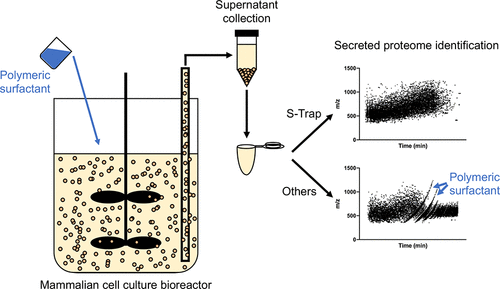当前位置:
X-MOL 学术
›
J. Proteome Res.
›
论文详情
Our official English website, www.x-mol.net, welcomes your
feedback! (Note: you will need to create a separate account there.)
S-Trap Eliminates Cell Culture Media Polymeric Surfactants for Effective Proteomic Analysis of Mammalian Cell Bioreactor Supernatants.
Journal of Proteome Research ( IF 3.8 ) Pub Date : 2020-03-24 , DOI: 10.1021/acs.jproteome.0c00106 Lucia F Zacchi 1 , Dinora Roche Recinos 1, 2 , Ellen Otte 2 , Campbell Aitken 2 , Tony Hunt 2 , Vanessa Sandford 2 , Yih Yean Lee 2 , Benjamin L Schulz 1, 3 , Christopher B Howard 1
Journal of Proteome Research ( IF 3.8 ) Pub Date : 2020-03-24 , DOI: 10.1021/acs.jproteome.0c00106 Lucia F Zacchi 1 , Dinora Roche Recinos 1, 2 , Ellen Otte 2 , Campbell Aitken 2 , Tony Hunt 2 , Vanessa Sandford 2 , Yih Yean Lee 2 , Benjamin L Schulz 1, 3 , Christopher B Howard 1
Affiliation

|
Proteomic analysis of bioreactor supernatants can inform on cellular metabolic status, viability, and productivity, as well as product quality, which can in turn help optimize bioreactor operation. Incubating mammalian cells in bioreactors requires the addition of polymeric surfactants such as Pluronic F68, which reduce the sheer stress caused by agitation. However, these surfactants are incompatible with mass spectrometry proteomics and must be eliminated during sample preparation. Here, we compared four different sample preparation methods to eliminate polymeric surfactants from filtered bioreactor supernatant samples: organic solvent precipitation; filter-assisted sample preparation (FASP); S-Trap; and single-pot, solid-phase, sample preparation (SP3). We found that SP3 and S-Trap substantially reduced or eliminated the polymer(s), but S-Trap provided the most robust cleanup and highest quality data. Additionally, we observed that SP3 sample preparation of our samples and in other published data sets was associated with partial alkylation of cysteines, which could impact the confidence and robustness of protein identification and quantification. Finally, we observed that several commercial mammalian cell culture media and media supplements also contained polymers with similar mass spectrometry profiles, and we suggest that proteomic analyses in these media will also benefit from the use of S-Trap sample preparation.
中文翻译:

S-Trap消除了细胞培养基聚合物表面活性剂,可对哺乳动物细胞生物反应器上清液进行有效的蛋白质组学分析。
生物反应器上清液的蛋白质组学分析可以告知细胞代谢状态,生存力,生产率以及产品质量,从而有助于优化生物反应器的运行。在生物反应器中孵育哺乳动物细胞需要添加聚合物表面活性剂,例如Pluronic F68,可减少搅拌引起的剪切应力。但是,这些表面活性剂与质谱蛋白质组学不兼容,必须在样品制备过程中消除。在这里,我们比较了从过滤的生物反应器上清液样品中去除聚合物表面活性剂的四种不同的样品制备方法:过滤辅助样品制备(FASP);背带; 单锅固相样品制备(SP3)。我们发现SP3和S-Trap大大减少或消除了聚合物,但是S-Trap提供了最可靠的清理和最高质量的数据。此外,我们观察到我们样品和其他已公开数据集中的SP3样品制备与半胱氨酸的部分烷基化有关,这可能会影响蛋白质鉴定和定量的置信度和鲁棒性。最后,我们观察到几种商业哺乳动物细胞培养基和培养基补充剂也包含具有相似质谱图的聚合物,并且我们建议这些培养基中的蛋白质组学分析也将从使用S-Trap样品制备中受益。这可能会影响蛋白质鉴定和定量的置信度和鲁棒性。最后,我们观察到几种商业哺乳动物细胞培养基和培养基补充剂也包含具有相似质谱图的聚合物,并且我们建议这些培养基中的蛋白质组学分析也将从使用S-Trap样品制备中受益。这可能会影响蛋白质鉴定和定量的置信度和鲁棒性。最后,我们观察到几种商业哺乳动物细胞培养基和培养基补充剂也包含具有相似质谱图的聚合物,并且我们建议这些培养基中的蛋白质组学分析也将从使用S-Trap样品制备中受益。
更新日期:2020-03-24
中文翻译:

S-Trap消除了细胞培养基聚合物表面活性剂,可对哺乳动物细胞生物反应器上清液进行有效的蛋白质组学分析。
生物反应器上清液的蛋白质组学分析可以告知细胞代谢状态,生存力,生产率以及产品质量,从而有助于优化生物反应器的运行。在生物反应器中孵育哺乳动物细胞需要添加聚合物表面活性剂,例如Pluronic F68,可减少搅拌引起的剪切应力。但是,这些表面活性剂与质谱蛋白质组学不兼容,必须在样品制备过程中消除。在这里,我们比较了从过滤的生物反应器上清液样品中去除聚合物表面活性剂的四种不同的样品制备方法:过滤辅助样品制备(FASP);背带; 单锅固相样品制备(SP3)。我们发现SP3和S-Trap大大减少或消除了聚合物,但是S-Trap提供了最可靠的清理和最高质量的数据。此外,我们观察到我们样品和其他已公开数据集中的SP3样品制备与半胱氨酸的部分烷基化有关,这可能会影响蛋白质鉴定和定量的置信度和鲁棒性。最后,我们观察到几种商业哺乳动物细胞培养基和培养基补充剂也包含具有相似质谱图的聚合物,并且我们建议这些培养基中的蛋白质组学分析也将从使用S-Trap样品制备中受益。这可能会影响蛋白质鉴定和定量的置信度和鲁棒性。最后,我们观察到几种商业哺乳动物细胞培养基和培养基补充剂也包含具有相似质谱图的聚合物,并且我们建议这些培养基中的蛋白质组学分析也将从使用S-Trap样品制备中受益。这可能会影响蛋白质鉴定和定量的置信度和鲁棒性。最后,我们观察到几种商业哺乳动物细胞培养基和培养基补充剂也包含具有相似质谱图的聚合物,并且我们建议这些培养基中的蛋白质组学分析也将从使用S-Trap样品制备中受益。











































 京公网安备 11010802027423号
京公网安备 11010802027423号